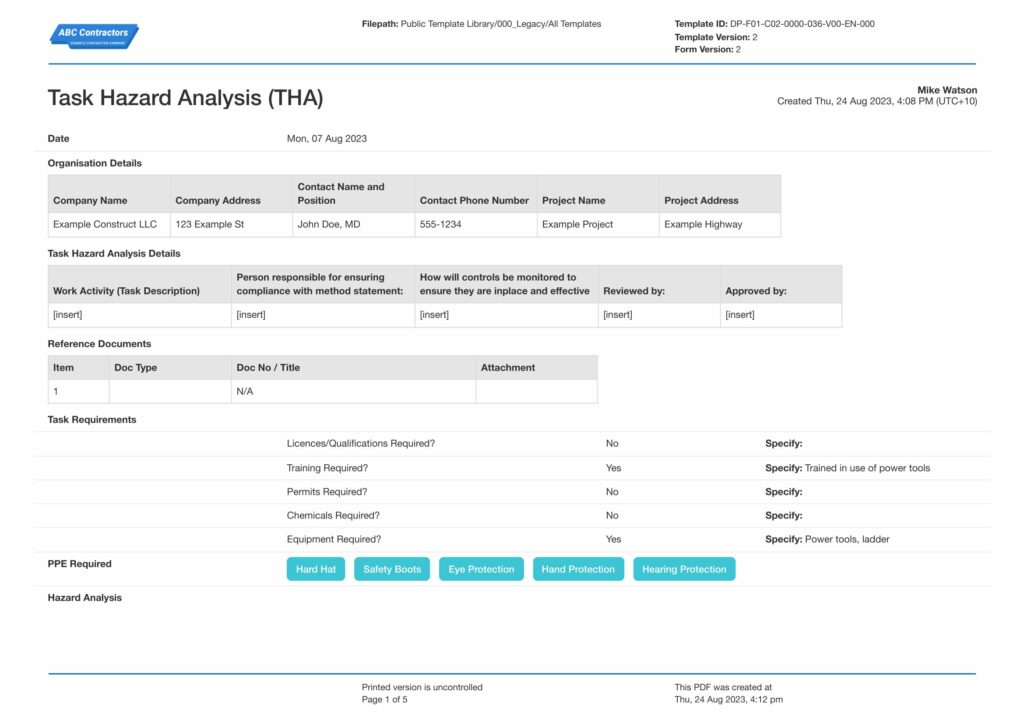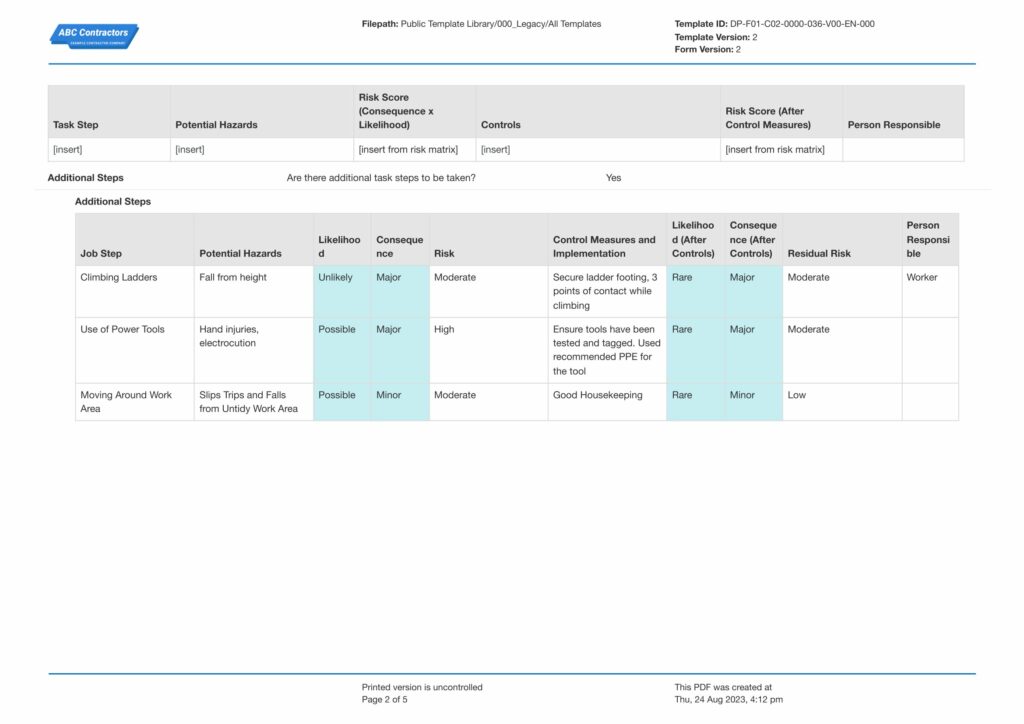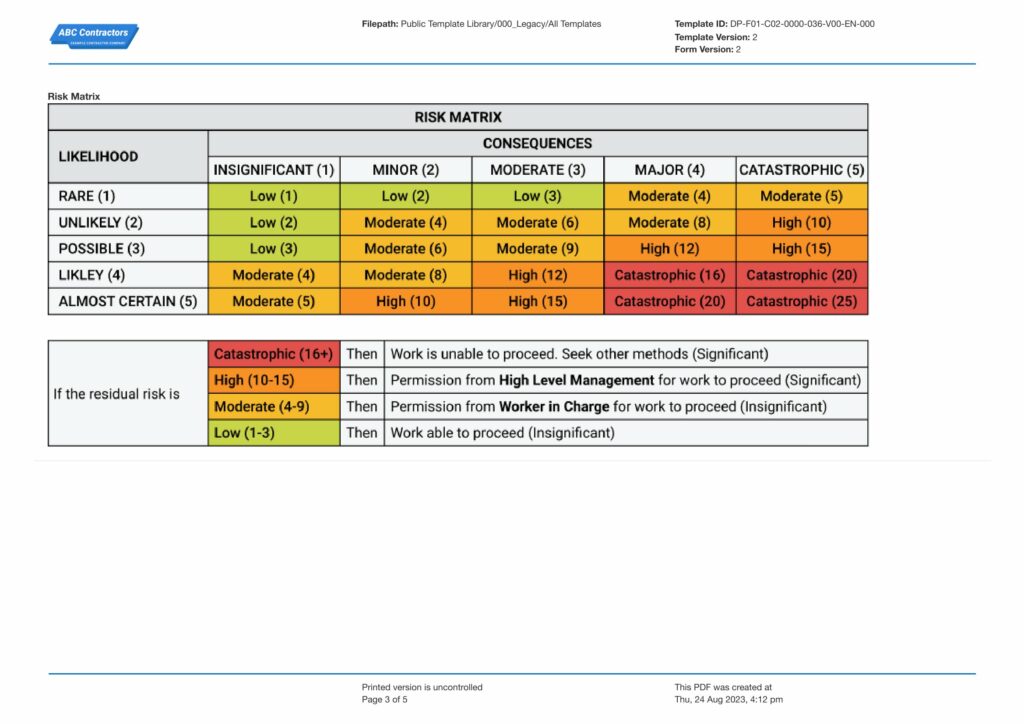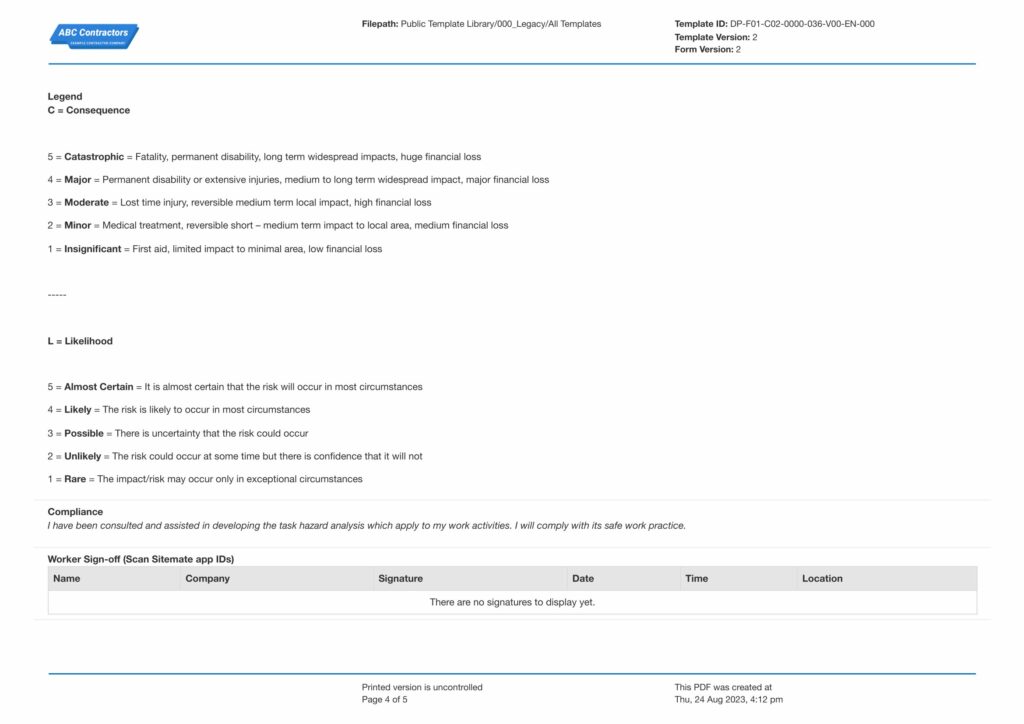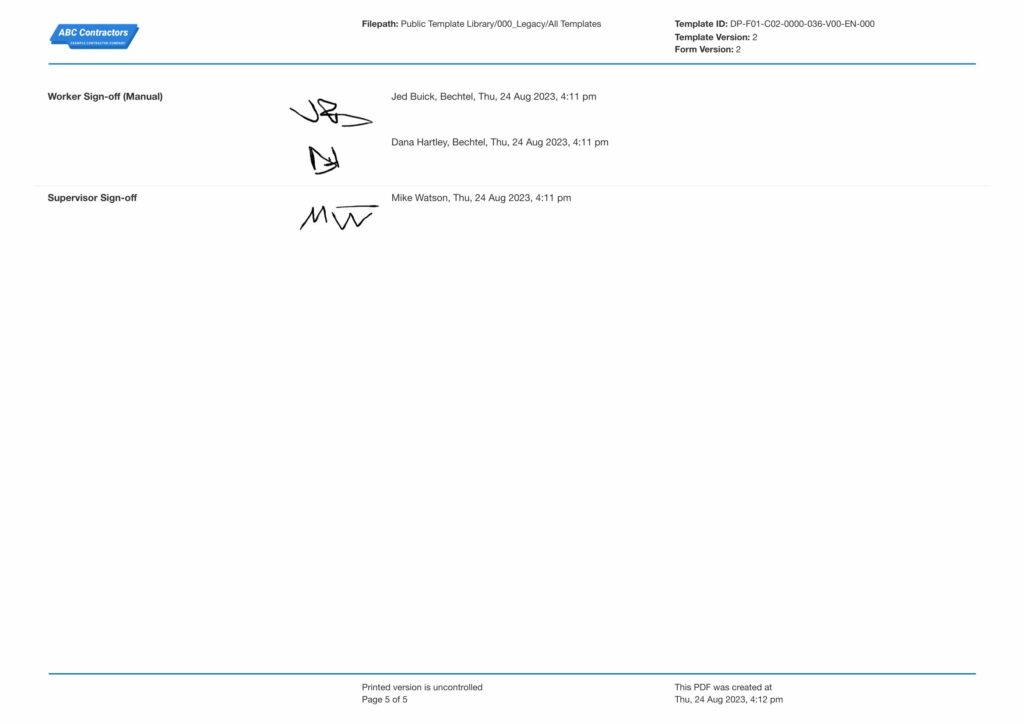Dashpivot article page – Task Hazard Analysis example
Task Hazard Analysis Example
This article walks you through a real-life Task Hazard Analysis example and all of the key components of any good THA, showing you and your team how to identify risks, plan safe work practices, and keep everyone protected on the job.
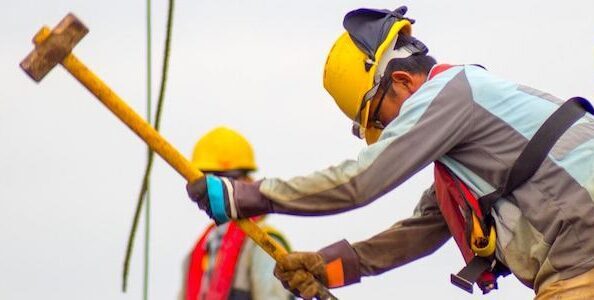
How Does a Task Hazard Analysis (THA) Differ From Other Safety Assessments?
A Task Hazard Analysis is a safety procedure done prior to starting a task, where the safety personnel identify, assess, and control the hazards. It works similarly to Job Hazard Analysis (JHAs) or a Field Level Hazard Assessment (FLHAs) but has its own unique place in a safety system. In this article, by showing you a task hazard analysis example, you can see where each safety mechanism is most useful.
The key aspects of any task hazard analysis are: (1) to break down the tasks into manageable steps, making it easier to identify and pinpoint the possible hazards that may occur; (2) to assess these hazards and/or risks using a Risk Matrix, and; (3) implement control measures; all while ensuring that workers are well-informed on the risks associated with the tasks, and that everything is in compliance with the safety regulations.
You can dig deeper into this topic in our dedicated what is a task hazard analysis article.
In most cases, a Task Hazard Analysis can be interchanged with a Job Hazard Analysis, but it’s important to take note the main differences between the two. They’re both safety procedures with the same goals, but they most definitely differ in scope, focus, and practice. A Task Hazard Analysis, basing from its name, is focused on a specific task within a job, while a Job Hazard Analysis is focused on the entire job role and all tasks related to it.
A THA analyses the steps within a task, while a JHA analyses the tasks under the job. A THA is often conducted as needed and necessary, while a JHA may only be done once. An example would be a carpenter climbing a ladder is under a THA, while assessing all tasks under a carpenter’s job is under the JHA.
A Task Hazard Analysis and a Field Level Hazard Assessment are two different safety tools, which mainly differ in scope, when they are conducted, and purpose. As mention already, a THA is task-specific, but a FLHA covers all the hazards that are present in the worksite at a particular time. A FLHA is conducted prior to a shift or whenever the site environment or conditions change, as opposed to a THA which is conducted before a task. A FLHA is broader, and is conducted daily or when conditions change like there are new workers, new equipment going in and out, or a change in weather. Basically, THA is task-specific, while a FLHA is site-wide.
A Task Hazard Analysis is used in industries where workers are prone to high-risk tasks that require additional measures to avoid anyone from getting hurt.
A few high-risk environment industries with dangerous tasks involved are the Construction, Manufacturing, Oil and Gas, Transportation, Agriculture, Utilities and Energy, Public Safety, and Aerospace. Any industry that deals with dangerous and hazardous tasks, or with heavy equipment, need to conduct Task Hazard Analysis prior to starting any task. This ensures that all workers are safe from hazards and all risks and hazards are identified early, avoids accidents, and ensures that the organisation maintains compliance with safety regulations.
The key persons responsible in performing a THA are supervisors, managers, safety officers, but workers who are performing the tasks, engineers, contractors, inspections, and more, are encouraged to collaborate and complete the THA process.
Task Hazard Analysis Example
The below Task Hazard Analysis example is designed to provide you with a general but proven structure that you can tweak and optimise to suit your own safety processes.
A Task Hazard Analysis Form/Report structure may change depending on the industry the organisation is in, the role, task, safety regulations, company policies, or simply the data needed by the safety personnel. The forms are designed to assist the key persons tasked to fulfil the Task Hazard Analysis.
Creating a standardised structure that perfectly fits the organisation’s needs is essential in being able to recognise and properly document the hazards.
Having a custom structure helps fill out the necessary details easily by the safety personnel, which in turn promotes an even safer working environment. Additionally, forms are a way of continuously complying with the safety regulations.

Use and customise this better task hazard analysis example
Use Case Example of Task Hazard Analyses
We looked at a dedicated task hazard analysis example above, and now we are going to explore example use cases for THAs, which might even require dedicated forms/processes depending on the nature of the task.
Let’s take, for example, the task is cutting wood using a circular saw, and the workers mainly involved are the carpenters.
The first step is dividing the task into steps and then identifying the hazards associated to those steps.
| Task Step | Potential Hazard | Risk |
|---|---|---|
| Handling the wood | Unstable workpiece | Equipment failure, cut |
| Cutting the Wood | High-speed blade, dangerous equipment | Injury |
| Cleaning the dust and debris | Dust inhilation, eye iritation | Resipiratory issues, vision obstruction |
| Storing the saw after using | Exposed blade | Trip, injury |
The second step is to conduct a risk assessment using the Risk Assessment Matrix. The severity and likelihood are either Low, Medium, and High. Using the Risk Assessment Matrix, navigate the risk level result for each hazard.
| Hazard | Severity | Likelihood | Risk Level |
|---|---|---|---|
| Unstable equipment | High | Medium | High |
| High-speed blade, dangerous equipment | High | Medium | High |
| Dust inhilation, eye iritation | Medium | High | Medium |
| Injury | High | Medium | High |
The third step is to jot down the control measures of each hazard identified using the Hierarchy of Controls.
| Hazard | Control Measures |
|---|---|
| Unstable equipment | Inspect equipment before using, replace damaged parts if necessary |
| High-speed blade, dangerous equipment | Make sure to wear PPE prior to starting task |
| Dust inhilation, eye iritation | Wear a dust mask, eye mask, use a dust extraction system, and ensure there is proper ventilation in the work area |
| Injury | Wear proper PPE, follow safety regulations |
Lastly, it’s important to communicate the Task Hazard Analysis to the carpenters, and have them sign off in the THA form to confirm that they have completed the Toolbox Talk and understand the risks posed.
How Can You Streamline Hazard Identification?
Dashpivot offers features that can streamline your organisation’s hazard identification in Task Hazard Analysis.
Instead of having printables in Word file, you can create your standardised THA forms to ensure that the contents are consistent, and that hazard are assessed properly. Using the drag-and-drop form builder in Dashpivot, you can change the look, structure, and contents of the THA form for workers to fill out. Add tables, text fields, pre-filled texts, checklists, yes/no sections, approval signatures, and many more. Use the very same forms to ‘create a form’ by simply using your mobile phones or tablets. Just take out your devices, and input the necessary details in the fields, save, and that’ll be stored in your centralised database. While you’ve saved that on the field, the employees in the office can access the document you just filled out and review the details. Dashpivot offers convenience and accessibility, making it a reliable digital tool to bring to the field.
When it comes to automation, Dashpivot has flexible formula fields with almost-similar syntax with Excel and you use leverage that in automating the risk levels by using IF or other conditional formulas. There are drop-down fields as well that you can choose from so that instead of typing in “High”, “Medium”, or “Low”, you’re just choosing from the list. This makes it work well with conditional formulas, since you won’t have to worry about wrong spellings.
Your organisation’s centralised database in Dashpivot is safe and secure, where permissions are layered across folders to ensure no one can easily access them and accidentally delete documents. You can change the permission in the settings when needed. Furthermore, folders are flexible, so you can arrange and rename them however you please. Dahspivot is the perfect tool that offers convenient, accessibility, flexibility, and ease of use.
How Does Dashpivot Improve Task Hazard Analysis Efficiency?
Standardising your Task Hazard Analysis forms allow organisations to be on track with safety regulations and their company policies. If you create a fill-out form that encourages only the important information to be input, then the workers will also only enter necessary data. This avoids any irrelevant information from being placed in all your Task Hazard Analysis forms.
Since everything is stored in the cloud, this feature promotes real-time collaboration between team members. With everything stored digitally, it makes it easier to store, search, and retrieve data when needed. Additionally, Dashpivot has a feature for advanced analytics. You can see the trends of hazards being identified in certain locations, create dashboards, charts, and studies necessary to build an even safer work environment.
Overall, streamlining your hazard identification through Task Hazard Analysis created in Dashpivot is going to make it a lot easier to identify hazards. You don’t have to worry about bothersome administrative tasks, since all of your focus is just simply making your workplace free of hazards.

JSA form
Complete and organise your daily diaries more efficiently.

Job Hazard Analysis
Complete and organise your daily diaries more efficiently.

Safety walk checklist
Use this form framework to conduct important safety walks
